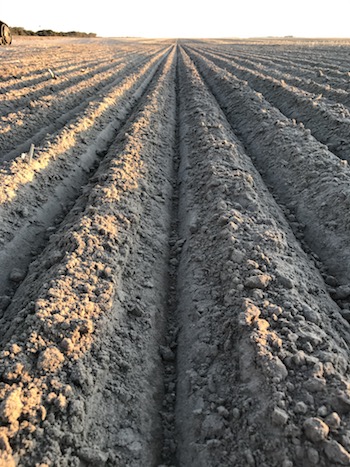Many growers ask whether they can use long knife-points to alleviate compaction and/or mix soil. The short answer is: not very well.
The long answer is: any benefits will be small and will vary with soil type, conditions, machine set-up and depth of compaction. Knife-points are a no-till implement, designed to make a furrow and limit soil disturbance. They will never de-compact or mix soil as effectively as dedicated implements.
Some growers believe long knife-points are not worth the extra drag and fuel consumption, while others report better establishment and some additional root growth where the points have worked into dense soils and shallow hardpans. Crop yield responses of 32 to 50 kilograms per hectare have been attributed to every additional centimetre of soil disturbance from direct drilling beyond the standard depth (Schmidt et al. 1994).
Compaction
Knife-points are not designed to shatter soil. Any compaction alleviation is minor, with limited sideways fracture and working only to the length of the knife-points, which is at most 23cm. This depth is usually only achievable in sandy soil as clayey and/or rocky soil, or limited horsepower, requires shorter points.
 Seeding with knife-points in progress. Photo: Quenten Knight, Agronomy Focus.
Seeding with knife-points in progress. Photo: Quenten Knight, Agronomy Focus.
Also, soil moisture affects efficacy. If the soil is too wet the points just slice through the soil, with the added risk of the soil not closing properly and seeds falling to the bottom of the trench. If it is too dry you will be using more fuel and horsepower, and wear points out faster.
If tyne pressure is high, knife-points can make a minor plough pan, but it is only as wide as the point.
Without a dedicated ripping operation, deeper subsoil compaction will still accumulate. Unless it is ameliorated, compaction will continue to hinder root growth and yield.
Top-dressed ameliorants such as lime are not likely to mix deeper than a few centimetres. To treat subsoil acidity (more than 10cm), lime needs to be properly mixed into the acid layer.
Knife-points can delve some soil, bringing up moist soil closer to the seed zone. This is useful in a drying profile but it does risk bringing up just enough moisture for the seed to imbibe, but not enough to germinate and survive. It can also bring up weed seeds.
The angle of the point (rake angle) affects the degree of soil delving and mixing. Lower angles –those that are more parallel to the surface – promote soil layer mixing and delving of deeper soil into the upper soil layers. As the angle increases and the point becomes more vertical, the degree of delving and mixing decreases. One study (Solhjou et al. 2011) found that with 120-millimetre points, a 35-degree angle brought up soil from 90mm deep and placed it near the furrow surface, while points at 90 degrees left the soil largely at depth.
Compared with dedicated mixing or delving, soil movement by knife-points is minor. Knife-points are unlikely to bring up enough subsoil to ameliorate non-wetting soil, or do a good job of mixing in soil amendments.
*This article was produced as part of the GRDC ‘Maintain the longevity of soils constraints investments and increase grower adoption through extension – western region’ investment (PLT1909-001SAX). This project is extending practical findings to grain growers from the five-year Soil Constraints – West suite of projects, conducted by the WA Department of Primary Industries and Regional Development, with GRDC investment.
References
Schmidt CP, Belford RK & Tennant D 1994, “Effect of different direct drilling and conventional sowing techniques on soil strength, root growth and grain yield of wheat on sandplain soils in Western Australia”, Australian Journal of Agricultural Research, vol. 45, pp. 547–564.
Solhjou A, Fielke JM & Desbiolles J 2011, “Effect of rake angle on soil movement induced by narrow point openers.” DOI: 10.13140/2.1.3020.2244

























































